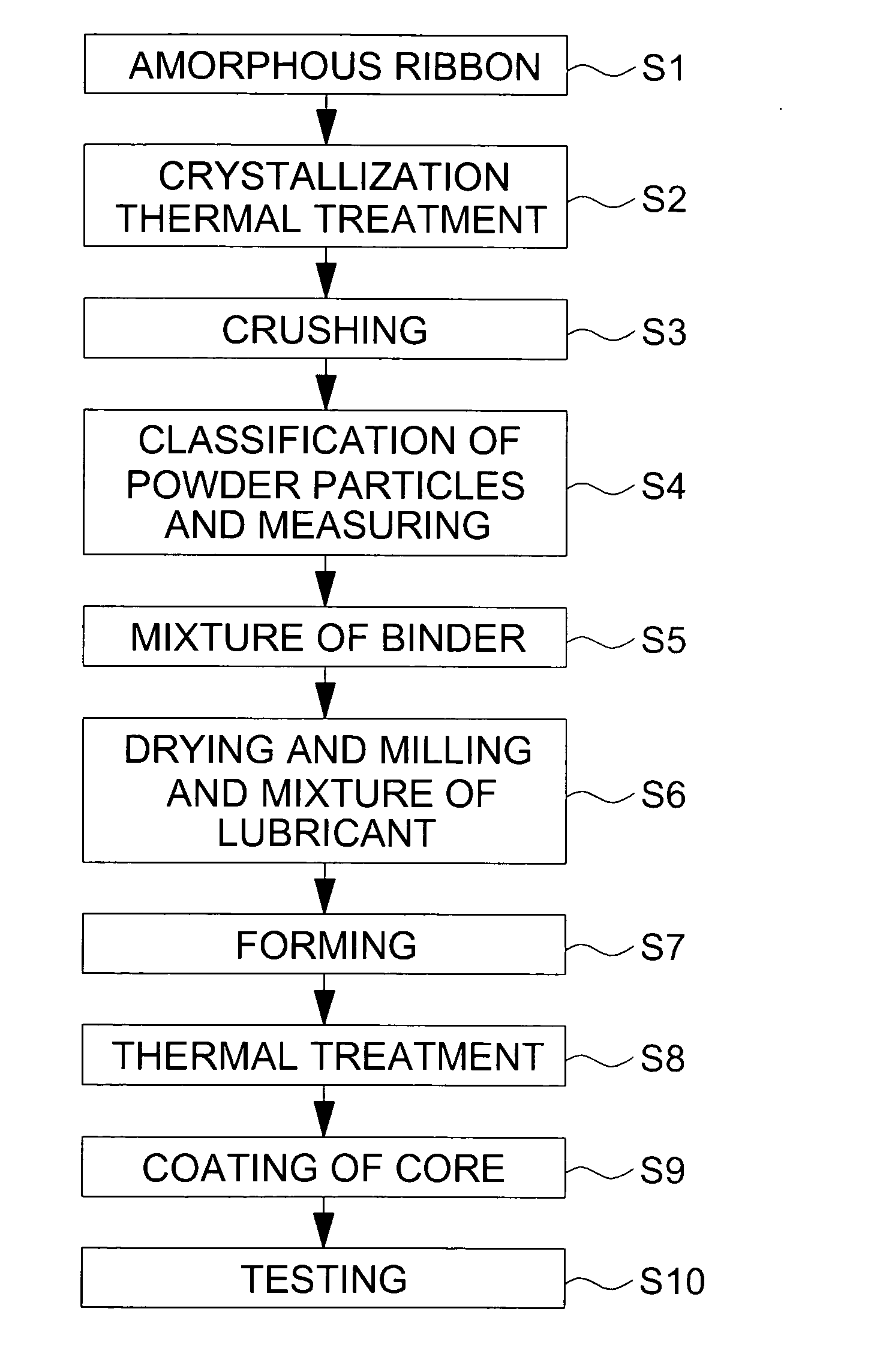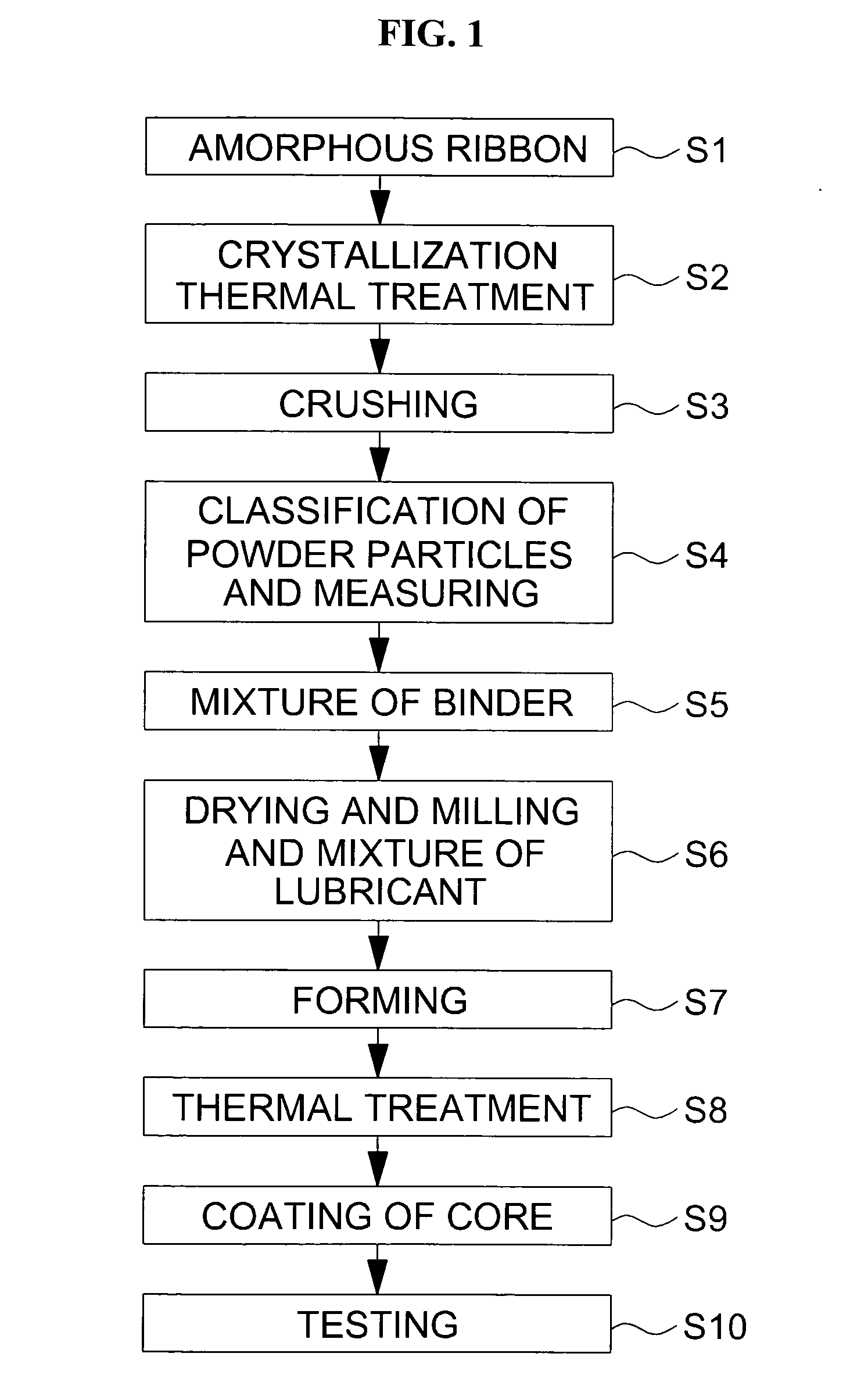Method for making nano-scale grain metal powders having excellent high-frequency characteristic and method for making high-frequency soft magnetic core using the same
a high-frequency characteristic technology, applied in the field of making nano-scale grain metal powders and making high-frequency soft magnetic cores, can solve the problems of low magnetic permeability, large magnetic deformation, inferior high-frequency characteristics, etc., to reduce processing costs, minimize eddy current loss, and excellent thermal stability
- Summary
- Abstract
- Description
- Claims
- Application Information
AI Technical Summary
Benefits of technology
Problems solved by technology
Method used
Image
Examples
embodiment 1
[0046] Embodiment 1
[0047] An amorphous ribbon having a composition of Fe73.5Cu1Nb3Si13.5B9 produced using a rapid solidification process (RSP), has been thermally treated for forty minutes at 540° C. under the nitrogen to thereby obtain a nano-scale grain ribbon. The crystallized grain size is 10 to 15 nm as shown in FIG. 2. After crushing the nano-scale grain ribbon by using a crusher, powder having passed through a sieve of −100˜+140 meshes of 50%, and powder having passed through a sieve of −140˜+200 meshes of 50% have been obtained through a classification and measurement of the powder particles.
[0048] Then, the produced nano-scale grain powder has been mixed with low melting point glass of 3 wt %, to then be dried. After having dried, a lump of the powder having been mixed with low melting point glass has been again crushed by using a ball mill, and then Zn-stearate of 0.5 wt % has been added to and mixed with the crushed powder. Thereafter, the powder having been mixed with t...
embodiment 2
[0057] Embodiment 2
[0058] In EMBODIMENT 2, a magnetic permeability of a ribbon and a size of crystallized grain which is obtained by nano-scale crystallizing and thermally treating the amorphous metal ribbon under the nitrogen at a temperature of 380 to 620° C. for 0.2 to 2 hours, have been measured. FIG. 5 illustrates change in a magnetic permeability according to change in a thermal treatment temperature, and Table 2 shows size of crystallized grain according to the thermal treatment temperature and the thermal treatment time.
[0059] In FIG. 5, a magnetic permeability has been compared according to the most proper time, which is a magnetic permeability at a ribbon state. Only when a ribbon-state magnetic permeability is 15000 or more, a feature of a magnetic permeability of 125 or more is embodied at 100 kHz and 1V after forming a core.
[0060] As can be seen from FIG. 5, a magnetic permeability of 15000 or more is embodied at a range between 400 to 600° C., and is not embodied at ...
embodiment 3
[0064] Embodiment 3
[0065] An amorphous ribbon has been produced in the same manner as that of EMBODIMENT 1. Powder having passed through a sieve of −100˜+140 meshes of 70%, and powder having passed through a sieve of −140˜+200 meshes of 30% have been used as powder particles of the nano-scale metal powder. When a core has been formed through an extruding former, cracks have occurred on the surface of the core, after having formed the core. Thus, the core has been broken after having treated the core thermally.
[0066] If powder having passed through a sieve of −100˜+140 meshes of 65% or more is used, it can be seen, from the experiments changing a distribution of powder particles of the metal powder, that cracks occur during forming and a core of a desired characteristic cannot be obtained.
PUM
| Property | Measurement | Unit |
|---|---|---|
| Temperature | aaaaa | aaaaa |
| Temperature | aaaaa | aaaaa |
| Fraction | aaaaa | aaaaa |
Abstract
Description
Claims
Application Information
 Login to View More
Login to View More - R&D
- Intellectual Property
- Life Sciences
- Materials
- Tech Scout
- Unparalleled Data Quality
- Higher Quality Content
- 60% Fewer Hallucinations
Browse by: Latest US Patents, China's latest patents, Technical Efficacy Thesaurus, Application Domain, Technology Topic, Popular Technical Reports.
© 2025 PatSnap. All rights reserved.Legal|Privacy policy|Modern Slavery Act Transparency Statement|Sitemap|About US| Contact US: help@patsnap.com



